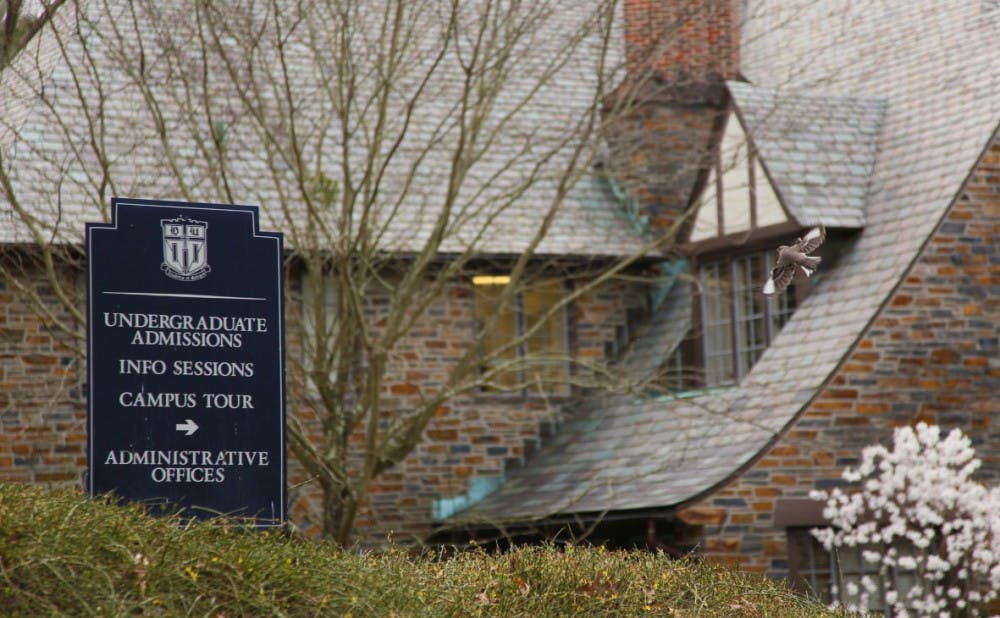Although black and Hispanic students are nationally more underrepresented at top schools today than they were 35 years ago, Duke has been making gradual improvements in representation.
The number of black first-years who enroll at elite schools has remained consistently around six percent since 1980, according to a New York Times analysis, even though black individuals comprised 15 percent of college-aged Americans in 2015. Similarly, Hispanics made up 13 percent of first-year enrollment at top schools, even though they constituted 22 percent of the college-age population.
Dean of Undergraduate Admissions Christoph Guttentag wrote in an email that the undergraduate admissions office does not have set quotas for diversity but rather tries to build a diverse applicant pool from which to choose.
“The characteristics of the incoming class tends to be driven by the nature of the applicant pool,” Guttentag wrote. “We do a significant amount of recruitment in order to have an applicant pool that will allow us to create a class that’s both talented and diverse. We don’t have specific targets when we begin an admissions cycle.”
The New York Times noted that affirmative action seemed to be effective at increasing the number of black and Hispanic students at universities.
To some, affirmative action might be seen as a quota-based endeavor, said Jay Pearson, assistant professor in the Sanford School of Public Policy. However, he clarified that in reality it operates as a goal-driven program to combat social disparities.
“Affirmative action is actually a social equity program," Pearson said, "and social equity programs are conceived of and brought into being to acknowledge historical structural and institutional impediments to full inclusion in society for certain targeted populations."
He added that although affirmative action is now thought of in the context of race, it was initially lower class and lower working class white women who disproportionately benefited from affirmative action programs in terms of access to high quality formal education.
Guttentag wrote that there has actually been a substantial increase in Duke's minority enrollment numbers over the past few decades.
“Our records go back to 1984. Back then students identifying as African-American/Black or Latino/Hispanic comprised six percent of the incoming class,” Guttentag wrote. “By comparison, 25 percent of the Class of 2021 identifies as African-American/Black or Latino/Hispanic.”
Guttentag added that much of this increase has taken place within the last few years alone. In the Fall of 2014, 20 percent of the incoming class identified as African-American or black and Latinx or Hispanic, he wrote. The New York Times’ data reveals that the two demographics combined comprised 22 percent of Duke’s incoming class in 2015.
Still, the application pool is limited by fundamental inequities, Pearson noted. He explained that college selection is way downstream from racial discrimination that transcends generations, such as school funding and residential segregations.
For many, Duke is simply unattainable from a socioeconomic standpoint, he said.
“It’s a complicated dynamic at a place like Duke because as it turns out, increasingly it looks like we are moving into an age where we have a two-tiered post-secondary educational system, where [with] the elite or flagship public institutions and the elite private institutions—particularly the Ivies and the Ivy-likes—it almost looks like many of the broader population cannot afford to make it here,” Pearson said.
Pearson noted that this is different from many liberal arts schools and non-elite universities, where minority populations are much more representative of national trends.
Guttentag wrote that many colleges do consider the inequities in educational opportunities and resources when they are recruiting students.
“For us, practices that include our partnerships with programs like [the Knowledge is Power Program] and QuestBridge, the Rubenstein Scholars program, our visits with community based organizations during our recruitment travel, or talking about our financial aid practices at every program we do, help us support students in the application process who don’t have every resource easily available,” Guttentag wrote. “Unfortunately, fundamental inequities remain in the opportunities students and families have in the primary and secondary educational system.”
Still, Duke does better with black first-year enrollment compared to some peer institutions. All Ivy League schools had nine percent or less black first-year enrollment, compared to Duke’s 11 percent. In fact, Duke has a greater or equal share of black freshmen enrollment than all the colleges that the New York Times categorized in “Other Top Universities,” which include top-ranked universities outside of the Ivy League.
However, Duke lags in terms of Hispanic enrollment, with all Ivy League schools—except Dartmouth at 10 percent—having 13 percent or more Hispanic first-years enrollment compared to Duke’s 11 percent.
Pearson noted that effective University leadership can play a major role in developing a representative student body.
“Duke will only do as good as the leadership allows it to do. My sense is that we have leadership here at Duke that is committed to the issues of diversity and inclusion, and we’ve certainly made strides in those areas in recent years,” he said. “Duke both understands and appreciates the value of diverse perspectives being represented in the classroom.”
With a recent change in leadership, new goals for diversity in the admissions office may indeed rest in the hands of President Vincent Price.
“I’m looking forward to learning from President Price what his and the Board of Trustees’ goals and priorities are for the coming years,” Guttentag wrote. “Until then, we’ll continue with what we’ve been doing.”
Get The Chronicle straight to your inbox
Signup for our weekly newsletter. Cancel at any time.

